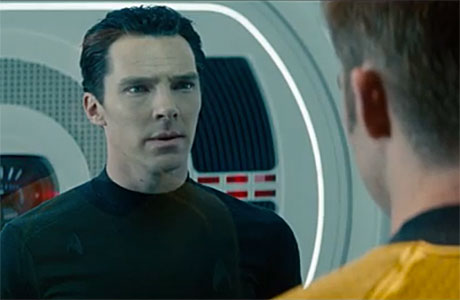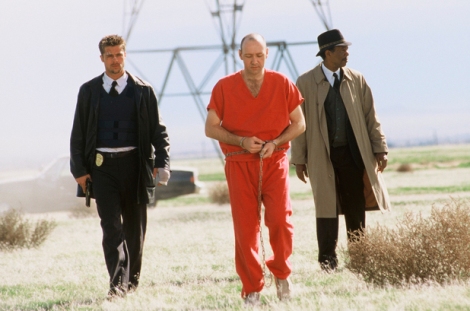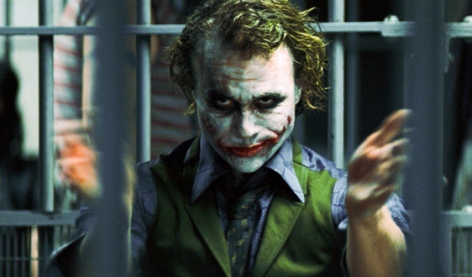I was just settling into the whole Khan versus Enterprise plot of Star Trek Into Darkness when something started to seem overly familiar to me about the way the story was developing. And I don’t mean familiar in that “Hey, they’re ripping off the Wrath Of Khan” way that began the moment Cumberbatch revealed his true age and identity. No, I mean the familiarly that began when the crew started to speculate that perhaps Khan had wanted to be captured. After all, it had all been so easy…
Why was this familiar to me? Maybe it was because I’d just seen the same thing in Skyfall. Ah ha, mystery solved. There again, we have a master criminal who goes out of his way to get caught. It’s all part of a master plan, you see. He wants to get caught so he can do even more damage from the inside.
Hollywood being Hollywood, if something works they do over and over until the audience begs them to stop. Maybe it’s time for us to beg for the Villain Who Wants To Get Caught plot to be retired.
Consider:
Star Trek Into Darkness (2013): Khan wants to get caught so he can highjack the Enterprise and free his people.
Skyfall (2012): Silva wants to get caught so he can break out of prison and assassinate M.
The Avengers (2012): Loki wants to get caught so he can get to Bruce Banner.
The Dark Knight Rises (2012): Bane wants to get caught by the CIA so he can kidnap a scientist.
The Dark Knight (2008): The Joker wants to get caught so he can blow up police HQ and kidnap a crooked banker.
There are probably more examples, but I think the point has been made.

I’m not knocking this plot. Hell, I like this plot. There’s a clear appeal here. For one thing, it establishes the villain as smarter (for the time being, anyway) than the hero. If you think about it, in each of the storylines above the hero or heroes far outnumber, outgun, and/or outmatch the villain. Khan is a superman, sure, but he’s just one dude against all of Star Fleet. Silva is just a guy with dentures and a bad dye job who’s trying to take on the British government. Loki is a goofball with an army of instantly destroyable galactic bugs that make the Trade Federation’s droid army look tough. Bane has, you know, respiratory issues. And the Joker is just a guy with some crap on his face.
But—and this is the point—they’re all smarter than whatever military or law enforcement operation is placing them into custody. Each villain has a scheme. He’s a master chess player who has planned several moves in advance. This leads directly into the second appeal of the plot which is that the villain is a badass. He’s such a stone cold criminal that he can turn himself over to the authorities and trust that everything will go according to plan. There’s something scary about that level of confidence. Watching these bad guys effortlessly brush away all the security and defenses meant to bind them, we’re led to ask how our hero will contend with—to lift a phrase from Khan—such a superior intellect.
In most cases, the Villain Who Wants To Get Caught plot comes in the middle of the film. It’s a nice middle act. After the set up in which the villain is established as a serious threat, there’s a big battle to capture the villain, followed by the stand off between hero and villain. Then the villain escapes, accomplishes whatever goal his fake capture was supposed to accomplish, at which point the third act begins and the hero fights his way back to victory.
The best example of this comes, of course, from The Dark Knight. You can feel The Joker’s presence hovering like a specter over nearly every other plot that’s followed him. The almost casual exercise of his power and intellect, the disregard for his own safety, the sheer damage that he inflicts—all this comes from that middle section of Christopher Nolan’s masterpiece. In some ways, maybe it all really just comes down to Batman and The Joker in the interrogation room. Their back and forth, the way it starts out as banter, moves into a philosophical debate, and culminates in horror when it turns out that Joker has had the upper hand all along. “You have nothing, nothing to threaten me with,” he tells Batman after taking several punches to the face. “Nothing to do with all your strength.” And he’s right.
Filmmakers have been trying to recapture that dark magic ever since, but it’s now turned into a cliché. All things considered, it has worked well enough. It was good for laughs in The Avengers. It allowed for some good Cumberbatching in Star Trek Into Darkness. But it’s never had the spark or snap of The Dark Knight. Maybe the lamest example was in Skyfall. I say it’s the lamest because, in fact, Silva’s plan doesn’t work. He goes through the trouble of getting caught, blowing up virtually all of London, and walks into the place where M is at…and misses. What an asshole. That is some kind of cut rate performance from a super villain. Understand, I’m not saying I wanted M to die and for Bond to go on a revenge quest; I’m just saying that the villain’s master plan here turns out to have been a gigantic waste of time and resources.

If all these movies are lifting from The Dark Knight, then it’s only fair to point out that The Dark Knight is lifting from David Fincher’s Se7en. That neo-noir gave us a villain whose ultimate plan was not only to get caught by the heroes but to be executed by them. The brilliance of the script by Andrew Kevin Walker is that John Doe is, in fact, successful. Of course, Se7en was a relatively low budget movie made in those halcyon days of 1995, and what we’re discussing here are heavyweight mega-franchises. The Dark Knight is the closest approximation to Se7en’s bleak worldview (for all intents and purposes, in fact, The Dark Knight is the Se7en of comic book movies), but each iteration of the Villain Who Wants To Get Caught dilutes the effect of the plot. By the time we get to Star Trek Into Darkness and Skyfall, it’s really just a gimmick.
Here’s hoping we don’t see Lex Luthor in handcuffs next year.
Jake Hinkson is the author of the books Hell On Church Street, The Posthumous Man, and Saint Homicide. Read more about him at JakeHinkson.com. He also blogs at The Night Editor.










